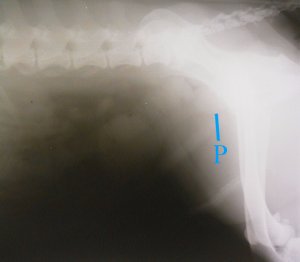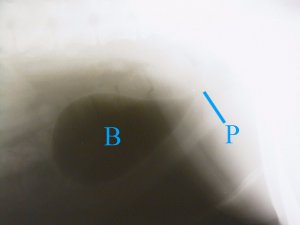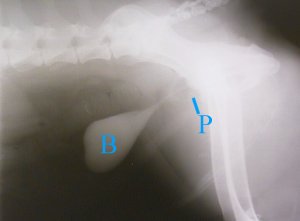 Back
Back
|
DISEASES OF THE PROSTATE Note for Pet Owners:
This information is provided by
Provet for educational purposes only.
You should seek the advice of
your veterinarian if your pet is ill as only he or she can correctly advise
on the diagnosis and recommend the treatment that is most appropriate for
your pet. Topics on this Page:
|
Description
The prostate is a reproductive sex organ about 2.5-3 cm in diameter which is
found in males. It is located adjacent to the urethra where it leaves the neck
of the urinary bladder, and prostatic secretions (which help to improve the
viability of sperm) are released into the urogenital tract just prior to, and
during ejaculation . Unless the prostate is greatly enlarged it is found within
the pelvic cavity lying below the rectum. When enlarged it can be found further
forward in the abdominal cavity. The normal prostate can usually be felt on the
floor of the pelvic canal by digital examination of the rectum.
Several types of prostatic disease occur in dogs, but they are rarely reported to occur in cats.:
- Hyperplasia - benign enlargement of the prostate - one of the most common problems seen in older dogs usually aged 6-10 years. In this condition the prostate can become greatly enlarged and causes problems because of its bulk.
- Prostatitis - inflammation of the prostate - usually due to infection
- Metaplasia - a benign enlargement of the prostate - a hormone sensitive change which may occur when oestrogens are given for therapeutic reasons, or when they are produced naturally in the body (eg by Sertoli cell tumours of the testes).
- Infection of the prostate - called prostatitis. Infection can be acute or chronic, and it may occur with other prostatic disease eg hyperplasia or cancer. If left untreated a prostatic abscess may form.
- Cancer - adenocarcinoma is the most common form of prostate cancer in male dogs
- Cysts - may not cause problems unless they are very large.
- Calculi - mineralised stones may form within the prostate gland
- Senile atrophy of the prostate - this occurs in old dogs over 11 years of age
Cause
Th
- Hyperplasia of the prostate is a normal hormone-related change in middle-aged to old males
- The female hormone oestrogen secreted by Sertoli cell tumours of the testes can cause prostatic enlargement due to metaplasia. This is one reason why castration may help in these cases.
- Infection - Prostatitis is usually caused by ascending urinary tract
infection. If untreated an abscess may form.
Organisms most often involved are :
- Escherichia coli
- Proteus spp
- Pseudomonas spp
- Staphylococci
- Streptococci
- Cysts - thought to be caused by obstruction of the ducts leading away from the prostate, or due to a congenital developmental abnormality. They can form within the prostate gland (called intraprostatic) or outside the prostate gland (called paraprostatic)
- Calculi - these often form secondary to the presence of infection (prostatitis)
- Senile atrophy - occurs following castration, or when normal testosterone production declines due to testicular atrophy in older males.
Breed Occurrence
There are no reported breed predispositions to develop prostatic disease
Signs
Th
e clinical signs of prostatic disease are similar whatever the underlying problem, and they usually relate to the excessive size of the prostate gland :- Defaecation - most common signs
- Constipation
- Difficulty passing faeces
- Straining when passing faeces (called tenesmus)
- Increased frequency of defaecation
- Passing thin "ribbon-like" stools
- Yelping when passing a motion - due to pain
- Urination
- Blood in the urine (haematuria). When blood is passed at the end of urination this is typical of prostatic abscesses.
- Difficulty passing urine (dysuria)
- Straining to pass urine (tenesmus)
- Straining after urination has finished
- Other signs
- Inappetance - especially with acute prostatitis
- High body temperature - when infection present
- Lethargy - acute prostatitis
- Vomiting (intermittent) - acute prostatitis
- Hindleg stiffness or neurological problems - due to pressure of the prostate on nerves supplying the hindlegs
- Pain on rectal examination
- Abdominal pain and arching of the back
- Recurrent itchiness (pruritus) in the anal area - chronic prostatitis
- Secondary complications
- Prostatitis is a secondary complication in other forms of prostatic disease
- Perineal hernia - as a result of excessive straining
- Prostatic cancer can spread to adjacent tissues eg the pelvis, and remotely (called metastatic spread)
Complications
- More than one prostatic disorder may be present in the same patient
- Perineal hernia/rupture due to excessive straining
- Secondary spread of prostatic cancer - especially to the skeleton (pelvis or spine), muscles, liver, lungs or spleen.
Diagnosis
The presence of prostatic disease is diagnosed by a variety of techniques
including the following :
- Evaluation of the presenting history and clinical signs
- Digital examination per rectum for:
- Size - enlarged or small
- Surface contour (smooth, irregular)
- Pain
- Imaging - which usually has to be performed with the animal under a general anaesthetic (Key B = urinary bladder, P = prostate)
- Radiography - plain

- Radiography - pneumocystogram (air contrast)

- Radiography - positive contrast

- Ultrasound examination - hyperplasia, prostatitis, neoplasia and abscesses may all produce the same echo patterns on ultrasound
On imaging the clinician is looking for prostate :
- size - enlargement in hyperplasia, cancer, abscesses and cysts
- position - in the abdomen if the gland is very enlarged with hyperplasia, cancer or cysts
- outline contour - smooth and symmetrical in hyperplasia, cysts, acute prostatitis ; irregular and asymmetrical in chronic prostatitis, abscess formation, intraprostatic cysts and cancer
- calcification may occur in prostatitis, cysts and especially in cancer
- increased radiodensity in the region of the prostate suggestive of peritonitis (seen in severe cases when the infection spreads to the pelivic or abdominal cavity).
and for evidence of secondary spread to local or remote tissues if it is a cancer:
- Examination of urine sediment for crystals (if calculi are present) or cancer cells .
- Culture of urine sample to identify bacteria
- Examination (cytology and bacterial culture) of fluid taken from the prostate by fine needle aspiration or prostatic washes.
- Histopathological examination of biopsy tissue - if cancer is suspected
Treatment
A variety of treatments are used in the management of prostatic disease
including :
- Castration - removes any Sertoli cell tumour and reduces male hormone production
- Steroid hormones
- Oestradiol benzoate - 1mg/day ; or 5mg/week by the subcutaneous or intramuscular route. Given weekly for 4 weeks, then once a month
- Diethylstilboestrol - 1mg/day by mouth
- Ethinyl oestradiol - 50-100 mg/day
- Demadinone acetate - 1-3mg/kg by subcutaneous or intramuscular route repeated as necessary
- Surgical removal of the prostate (prostatectomy) - especially for cancer . This is a difficult procedure and is not routinely performed in veterinary practices.
- Antibiotics - when prostatitis is present. High doses are needed for at
least 10 days, and choice of antibiotic should be based on culture and
sensitivity of the organisms. Recommended choices of antibiotic
include
- Erythromycin
- Metronidazole
- Trimethoprim sulphonamide combinations
- Fluid-filled cysts can be drained (aspirated) but they refill. Sometimes a permanent drainage hole can be made in the cyst wall by attaching it to the abdominal wall (called marsupialisation)
Prognosis
Good for most forms of prostatic disease - but poor for prostate cancer,
especially if it has already spread.
Long term problems
- Recurrent infection is a common problem and long term antibiotics may be needed
Updated October 2013